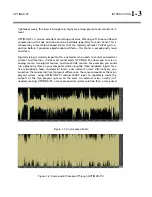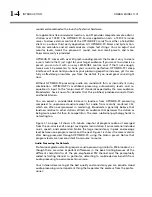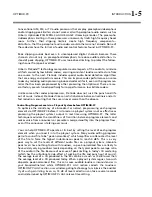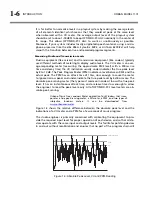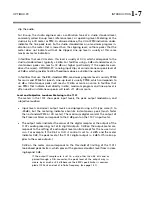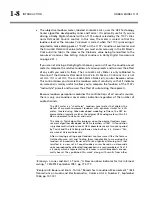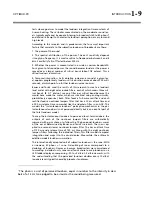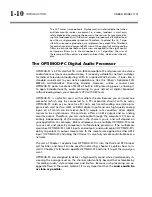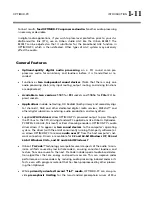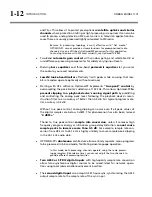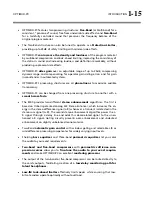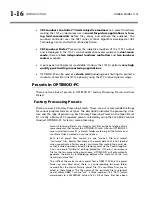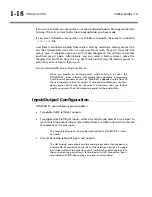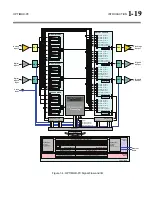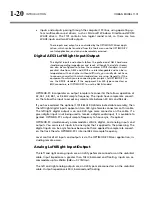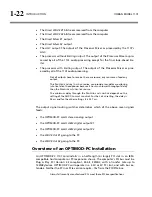
OPTIMOD-PC
INTRODUCTION
1-9
tests whose goal was to model the loudness integration time constants of
human hearing. These studies concentrated on the moderate sound lev-
els typically preferred by people listening to broadcasts (60 to 80 phons
)
and did not attempt to characterize loudness perception at very low and
high levels.
According to this research and its predecessors, the four most important
factors that correlate to the subjective loudness of broadcasts are these:
1. The power of the sound.
2. The spectral distribution of the power. The ear’s sensitivity depends
strongly on frequency. It is most sensitive to frequencies between 2 and 8
kHz. Sensitivity falls off fastest below 200 Hz.
3. Whether the power is concentrated in a wide or narrow bandwidth.
For a given total sound power, the sound becomes louder as the power is
spread over a larger number of
critical bands
(about 1/3 octave). This is
called
loudness summation
.
4.
Temporal integration
: As its duration increases, a sound at a given lev-
el appears progressively louder until its duration exceeds about 200 milli-
seconds, at which point no further loudness increase occurs.
Bauer and Torick used the results of this research to create a loudness
level meter with eight octave-wide filters, each of which covers three crit-
ical bands. (B & T did not use one filter per critical band because this
would have made the meter, which was realized using analog circuitry,
prohibitively expensive.) Each filter feeds a full-wave rectifier and each
rectifier feeds a nonlinear lowpass filter that has a 10 ms attack time and
a 200 ms release time, somewhat like the sidechain filter in an AGC. This
models the “instantaneous loudness” perception mechanism in the ear.
Instantaneous loudness is not perceived directly but is an essential part of
the total loudness model.
To map the instantaneous loudness to perceived short-term loudness, the
outputs of each of the nonlinear lowpass filters are arithmetically
summed with gains chosen to follow the 70 phon equal-loudness curves
of the ear as determined by Bauer and Torick’s research. The sum is ap-
plied to a second, slower nonlinear lowpass filter. This has an attack time
of 120 ms and a release time of 730 ms. Along with the eight nonlinear
lowpass filters following the individual filters, this filter models temporal
integration and maps it to the visual display. Meanwhile, the arithmetic
addition models loudness summation.
The internationally accepted unit of subjective loudness is the
sone.
With
a sinewave,
40 phons = 1 sone. A doubling of sones corresponds to a
doubling of loudness. However, because broadcasters were accustomed
to working in decibel units, Jones and Torick chose to map loudness on a
LED ladder display encompassing –20 to +5 dB in 0.5 dB increments, with
the understanding that the perceived loudness doubles every 10 dB at
loudness levels typically heard by broadcast audiences.
3
The phon is a unit of perceived loudness, equal in number to the intensity in deci-
bels of a 1 kHz tone judged to be as loud as the sound being measured.
Summary of Contents for Optimod-PC 1101
Page 4: ......
Page 14: ......
Page 121: ...OPTIMOD PC OPERATION 3 1 Section 3 Operation Figure 3 1 The OPTIMOD PC Control Application...
Page 192: ...3 72 OPERATION ORBAN MODEL 1101...
Page 204: ......
Page 210: ......
Page 212: ...5 2 UNINSTALLATION ORBAN MODEL 1101...
Page 236: ......









